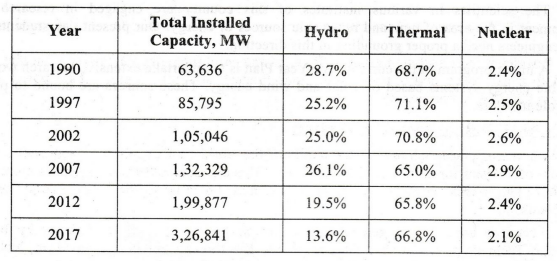Basic Civil & Mechanical Engineering: UNIT I: n. Energy engineering
Future planning
Energy engineering
The following table gives the total installed capacity and percentage installed capacity by various means of power generation in India
FUTURE PLANNING
The
following table gives the total installed capacity and percentage installed
capacity by various means of power generation in India:

1. NATIONAL GRID SYSTEM
Due
to uneven distribution of energy resources, it was not possible to plan equal
power development in all states of the country. To solve this problem,
Government of India has divided the country into five regions, viz., Northern,
Western, Southern, Eastern and Northeastern regions.
Yes!
In our country different power resources are available in different states.
Therefore, in order to ensure constant supply to all the consumers throughout
the year, interlinking of various power plants is essential so that spare
capacity of one power station can be utilized by the other. With this objective
in view, programme for integrated power generation on regional basis by
interlinking the power stations of adjoining states has started working and
successful functioning of regional grids may finally give way to National Grid
System.
Five
regions already have interconnected power systems, namely, Northern, Western,
Southern, Eastern and Northeastern regions.
Advantages
1.
National Grid System enables the base load to be supplied by the most
economical power stations and peak demand to be supplied by the more expensive
power stations.
2.
It provides security against all normal operating hazards with a small margin
of spare capacity.
2. SUPER THERMAL POWER STATIONS
Further
the Government has planned to set up five Super Thermal Power Stations, each of
2000 MW capacity at Tamil Nadu (Neyveli), Andhra Pradesh (Ramagundam), U.P.
(Singrauli), Madhya Pradesh and West Bengal.
The
future planning for power development should aim at the optimum exploitation of
the abundant resources available so that a proper mix of hydro, thermal and
nuclear capacity is achieved. The danger of exhausting the fossil fuels by the
end of 21st century is the major problem before the energy hungry civilization.
The
scientists in various institutes of this country are engaged in research and
development in the area of new and renewable sources of energy. Our present day
students and future engineers need a proper grounding in this direction.
A
major program in the current Five-Year Plan is to undertake extensive research
work of renewable energy systems based on solar and wind energy. These sources
are bound to play a major role in future.
Basic Civil & Mechanical Engineering: UNIT I: n. Energy engineering : Tag: : Energy engineering - Future planning
Related Topics
Related Subjects
Basic Civil and Mechanical Engineering
BE3255 2nd Semester 2021 Regulation | 2nd Semester EEE Dept 2021 Regulation
